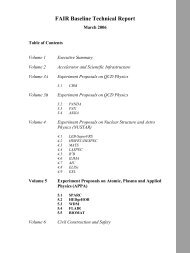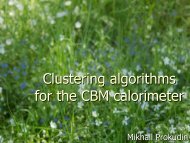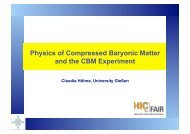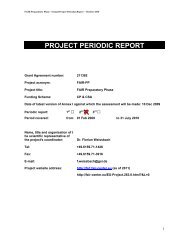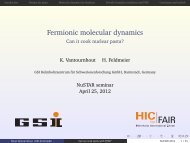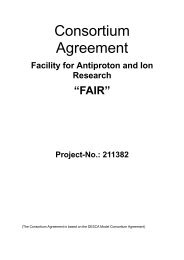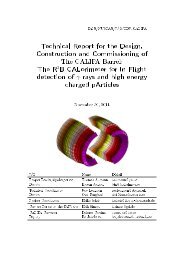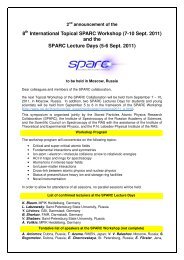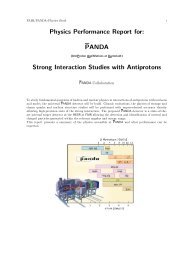NeuLAND - FAIR
NeuLAND - FAIR
NeuLAND - FAIR
Create successful ePaper yourself
Turn your PDF publications into a flip-book with our unique Google optimized e-Paper software.
spectrum, absorption length, refraction index, decay times, scintillation yield etc.. In<br />
order to determine reflection properties, we made use of the possibility of defining optical<br />
borders in GEANT4. In this simulation a polished dielectric-metal border between the<br />
scintillator and a surrounding aluminum foil was chosen. Figure 4.10 shows the used<br />
geometries for the light guides and some snapshots of photon tracking. The first row<br />
shows the standard case with the PM directly coupled to the scintillator without a<br />
light guide. The other rows show light guides with pyramidal, spherical, and parabolic<br />
shapes. In the figure only the coupling to the 1 inch photomultiplier is shown but similar<br />
simulations were performed for the 1.5 inch photomultiplier. For the scintillator module,<br />
consisting of RP408 material, we chose the dimensions 5 × 5 × 200 cm. The light-output<br />
was simulated based on a 50 MeV proton crossing the center of the scintillator bar. On<br />
average 315000 optical photons were produced and in the table we list the numbers of<br />
detected photons for the corresponding geometry for the photomultiplier with 1 and<br />
1.5 inch, accordingly. The second far end of the scintillator was covered with a fictitious<br />
photomultiplier covering the full area. On average 53000 photons were detected on this<br />
”ideal read out” at this side.<br />
We do not observe a substantial increase in read-out photons when applying light guides.<br />
The photon tracking pictures displayed in the right column of figure 4.10 can serve to<br />
interpret this effect as detailed in the following. Photons which are often reflected and<br />
have large angles relative to the scintillator surface are often reflected back into the<br />
scintillator bar by the light guide, while, in absence of a light guide, they had hit the<br />
photomultiplier window. On the other hand, photons which travel almost parallel to<br />
the scintillator but do not hit the photomultiplier directly have a high probability to<br />
be reflected by the light guide into the direction of the photomultiplier. In total, the<br />
number of photons hitting the photomultiplier stays almost constant. However, the<br />
arrival time distribution of the photons is affected. This can be seen in Figure 4.11<br />
where the simulated arrival time for the different light guide geometries is presented.<br />
Relative to the case without light guide the amount of photons with short travel times<br />
(”early” photons) are enhanced in cases with introduced light guides. Thus, the implementation<br />
of light guides could lead to an improved time resolution since the fastest<br />
photons determine the timing properties. For the 1 inch case, the light guides formed<br />
like a truncated pyramid and the parabolic one, show very good performance. Following<br />
closely these findings, we propose for the <strong>NeuLAND</strong> submodules light-guides of conical<br />
shape for practical reasons, see section 5.2.2.<br />
In order to obtain information on the number of photons expected close to the detection<br />
threshold, electrons with an energy of 1 MeV were also simulated. In this case about<br />
300 photons were detected with a 1 inch and 600 with a 1.5 inch photomultiplier.<br />
49





